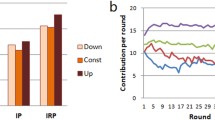Abstract
Virtually all uses of repeated games tostudy of cooperation assume that people'stime discount rates are exogenous andfixed. Here we offer an evolutionary gameembedded in a multi-period model ofinvestment and consumption in whichindividual time discounts are determined bytheir convergence to values determined byEvolutionary Stable Strategies. Oursubstantive motivation, though, iscorruption and its relationship to economicgrowth. To understand the observedrelationship between levels of corruptionand economic indicators of social welfare,we argue that corruption is a form ofcooperation that requires closeinterpersonal monitoring. If we assume,moreover, that when people discount thefuture greatly the only sustainable formsof cooperation are those that allow forclose monitoring, then our analysis can beinterpreted as a dynamic model of therelationship between corruption andinvestment.
Similar content being viewed by others
References
Andvig, J.C. and Moene, K.O. (1990). How corruption may corrupt. Journal of Economic Behavior and Organization 13: 63-76.
Becker, G. and Mulligan, C.B. (1997). The endogenous determination of time preference.Quarterly Journal of Economics 112: 729-758.
Bicchieri, C. and Rovelli, C. (1995). Evolution and revolution: The dynamics of corruption. Rationality and Society 7: 201-224.
Boylan, R., Ledyard, J., Lupia, A., McKelvey, R.D. and Ordeshook, P.C. (1991). Political competition in a model of economic growth: An experimental study. In: T. Palfrey (Ed.), Laboratory research in political economy. Ann Arbor: University of Michigan Press.
Cadot, O. (1987). Corruption as a gamble. Journal of Public Economics 33: 223-244.
Dixit, A. and Skeath, S. (1999). Games of strategy. N.Y.: Norton
Friedman, E., Johnson, S., Kaufmann, D. and Zoido-Lobaton, P. (2000). Dodging the grabbing hand: The determinants of unofficial activity in 69 countries. Journal of Public Economics 76: 459-493.
Greif, A., Milgrom, P. and Weingast, B.R. (1998). Coordination, commitment, and enforcement, In: J. Knight and I. Sened (Eds.), Explaining social institutions. Ann Arbor: University of Michigan Press.
Hedlund, S. (2001). Can property rights be protected by law?. East European Constitutional Review 10: 48-52.
Jain, A.K. (2001). Corruption: A review. Journal of Economic Surveys 15: 71-121.
Johnson, S., Kaufmann, D., McMillan, J. and Woodruff, C. (2000).Why do firms hide? Bribes and unofficial activity after communism. Journal of Public Economics 76: 495-520.
Kneen, P. (2000). Political corruption in Russia and the Soviet legacy. Crime, Law and Social Change 34: 349-367.
Lui, F.T. (1986). A dynamic model of corruption deterrence. Journal of Public Economics 31: 215-236.
Mauro, P. (1997). The effects of corruption, investment and government expenditure. In: K.A. Elliot (Ed.), Corruption and the global economy, 83-107. Washington D.C.: Institute for International Economics.
Mo, P.H. (2001). Corruption and economic growth. Journal of Comparative Economics 29: 66-79.
Posner, E.A. (2000). Law and social norms. Cambridge, MA: Harvard University Press.
Rose-Ackerman, S. (1999). Corruption and government. Cambridge: Cambridge University Press.
Shleifer, A. and Vishny, R. (1993). Corruption. Quarterly Journal of Economics 108: 599-618.
Waller, C.J., Verdier, T. and Gardner, R. (2000). Corruption: Top down or bottom up. Mimeo. Department of Economics, University of Kentucky.
Wei, S. J. (2000). Local corruption and global capital flows. Brookings Papers on Economic Activity 2, Washington D.C.
Yamagishi, T., Cook, K.S. and Watabe, M. (1998). Uncertainty, trust and commitment.American Journal of Sociology 104: 165-194.
Author information
Authors and Affiliations
Rights and permissions
About this article
Cite this article
Klochko, M.A., Ordeshook, P.C. Corruption, Cooperation and Endogenous Time Discount Rates. Public Choice 115, 259–283 (2003). https://doi.org/10.1023/A:1024268211998
Issue Date:
DOI: https://doi.org/10.1023/A:1024268211998




